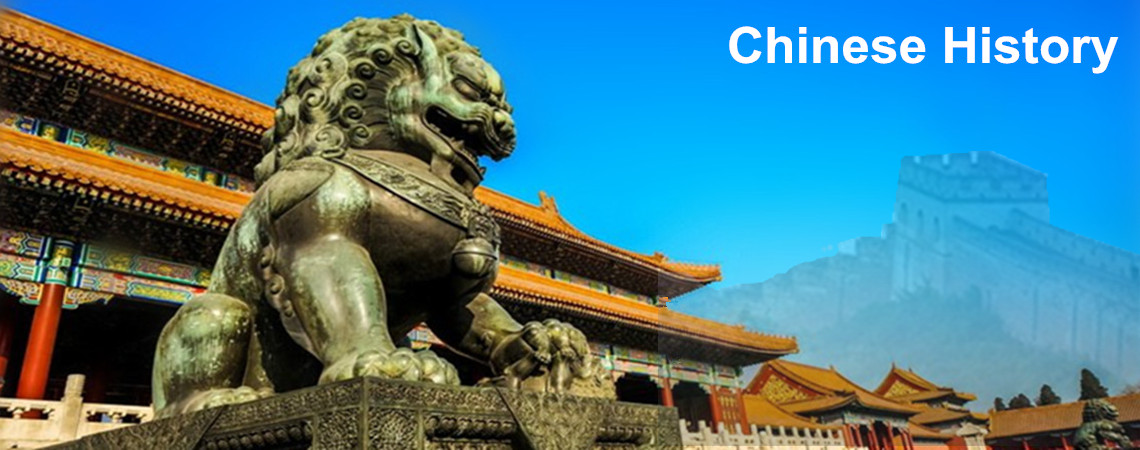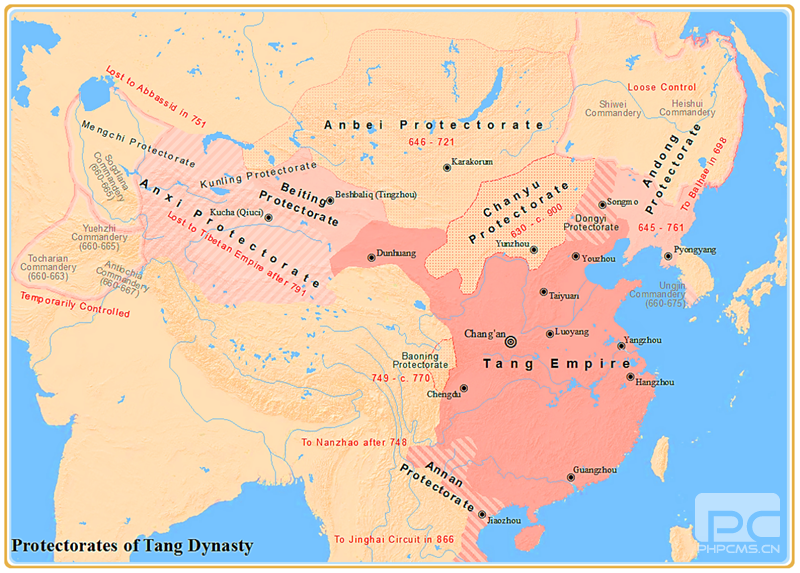
Tang Dynasty (618-907)
Facts of the Tang Dynasty
Time: 618 -907
Location of Capital: Chang'an ( Xian)
Emperors: Liyuan, Li Shimin, Lizhi
Replaced by: Song Dynasty
Early Period of the Tang Dynasty
Tang Dynasty clan, the Li family, was an important military force during the Sui empire. In the last period of Sui, people hated the dynasty's imposition of high taxes, forced labor for the huge construction projects, and the wars. The Sui Dynasty was on the verge of collapse.
Emperor Gaozu (Ruled 618-627)
 Emperor Gaozu, born as Li Yuan, was the founder of the Tang Dynasty. At the end of Sui Dynasty (581 - 618), Li Yuan was the chief officer of Taiyuan. In 617, Li Yuan was encouraged by his son, Li Shimin, and raised an army in Taiyuan, then he captured the capital city Chang'an ( Xian). Li Yuan put Yang You (son of the Emperor Yang) on the throne as Emperor Gong. Meanwhile, Li Yuan proclaimed himself the prime minister. In 618, Li Yuan proclaim himself emperor and changed the state title into Tang, still with Chang'an as the capital city.
Emperor Gaozu, born as Li Yuan, was the founder of the Tang Dynasty. At the end of Sui Dynasty (581 - 618), Li Yuan was the chief officer of Taiyuan. In 617, Li Yuan was encouraged by his son, Li Shimin, and raised an army in Taiyuan, then he captured the capital city Chang'an ( Xian). Li Yuan put Yang You (son of the Emperor Yang) on the throne as Emperor Gong. Meanwhile, Li Yuan proclaimed himself the prime minister. In 618, Li Yuan proclaim himself emperor and changed the state title into Tang, still with Chang'an as the capital city.
Emperor Taizong ((Ruled 627-649)
Emperor Taizong, Li Shimin, was the second son of the Emperor Gaozu. He made a great contribution in the rebellion against Sui. In 626, he killed his two brothers and then took the throne after Emperor Taizu retired. This was known as the "Xuanwu Gate Incident".
Under Emperor Taizong Li Shimin's wise governing, the national strength and social development reached an unparalleled prosperity - economy and commerce flourished, the social order was stable, corruption never existed in the court and the national boundaries were even open to foreign countries. This made the country first strong economy and the commercial enterprise throughout the world. And this period was called "Prosperity of Zhenguan".
Confucian Officials
He ordered the Tang court to use imperial examinations to appoint many Confucian scholars to the ruling bureaucracy. These examinations tested the candidates' literary skills and knowledge of Confucian texts.
Buddhism's Rise
He promoted Buddhism in the Tang Dynasty. He also promoted Nestorian Christianity. During his reign, the empire prospered. Silk Road trade flourished, and Emperor Taizong received foreign emissaries in Chang'an.Early in the Tang era, the spread of Buddhism was assisted with the invention of woodblock printing techniques. Buddhist texts and charms were printed and disseminated.
Diplomatic Policy
Emperor Taizong also instituted a legal code that served as a model for following eras and for the governments of other countries, such as Korea and Japan.In 635, a Nestorian named Alopun went to Chang'an. Emperor Taizong approved of the preaching of the religion all over the empire and ordered the construction of a church in Chang'an. Many people became Nestorian Christians and churches were built in some cities.
Middle Period of the Tang Dynasty
During these years, the Tang Dynasty reached its height before the An Lushan Rebellion in 756.The empire prospered under stable rule for a while and there was a period of relative peace and prosperity afterwards. Chang'an became one of the biggest cities in the world. Along with the increase of wealth and urbanization, art and literature flourished.
Emperor Xuanzong (Ruled 712–762)
Late Period of the Tang Dynasty
In his old age, Emperor Xuanzong was complacent and indifferent to state affairs. Hopelessly, he indulged himself in the beauty of his concubine Yang Yuhuan. Besides, he also appointed some wicked chancellors who corrupted the political order. Meanwhile, troops on the frontiers gradually gathered together and formed a powerful military force.
An Shi Rebellion (755-763)
An Lushan was a general of a large Tang army. He was of Central Asian descent. In 755, An Lushan aligned with Shi Siming and launched a rebellion, called the An Shi Rebellion which lasted for eight years and heavily knocked the Tang regime. In 755 and captured the major Tang city of Luoyang. Then he captured Chang'an. The emperor fled the city.The Tang army recaptured it a year later. Shortly after that, An Lushan was killed. The rebellion lasted for 8 years and ended in 763, but it severely weakened the empire.
From then on, the national strength was weakened daily by separatist forces in local areas. Because of the incompetence of the emperors the dominance of the eunuchs and power struggles between chancellors became increasingly intense. Hence the Tang Dynasty declined from generation to generation.
In 763, taking advantage of the An Lushan Rebellion, the Tibetan empire attacked the Tang empire and captured a large part of the northern land area including Chang'an.
End of the Tang Dynasty
Peasant Up-rising
In 874, a large peasant rebellion called the Huang Chao Rebellion broke out. People who survived the flooding and famine rose up against the government. Both Chang'an and Luoyang were captured, and the dynasty was greatly weakened.
Five Dynasties and Ten States
After Zhu Wen (also called Zhu Quanzhong) usurped the Tang Dynasty (618-907) and founded the Later Liang Dynasty (907 - 923), there were sequentially four dynasties after that. All these five dynasties were called Five Dynasties in Chinese history. Meanwhile, there were also ten kingdoms originating from the former Jiedushi (regional military attachment) of Tang Empire.
In 904, Emperor Ai was chosen to be the puppet ruler by a military governor, Zhu Wen. Then in 907, Emperor Ai was forced to abdicate and Zhu took the throne. Zhu Wen changed the empire to the Later Liang Dynasty. That was the end of the Tang Dynasty and the beginning of the Five Dynasties and Ten Kingdoms.






 Ask Questions ?
Ask Questions ?